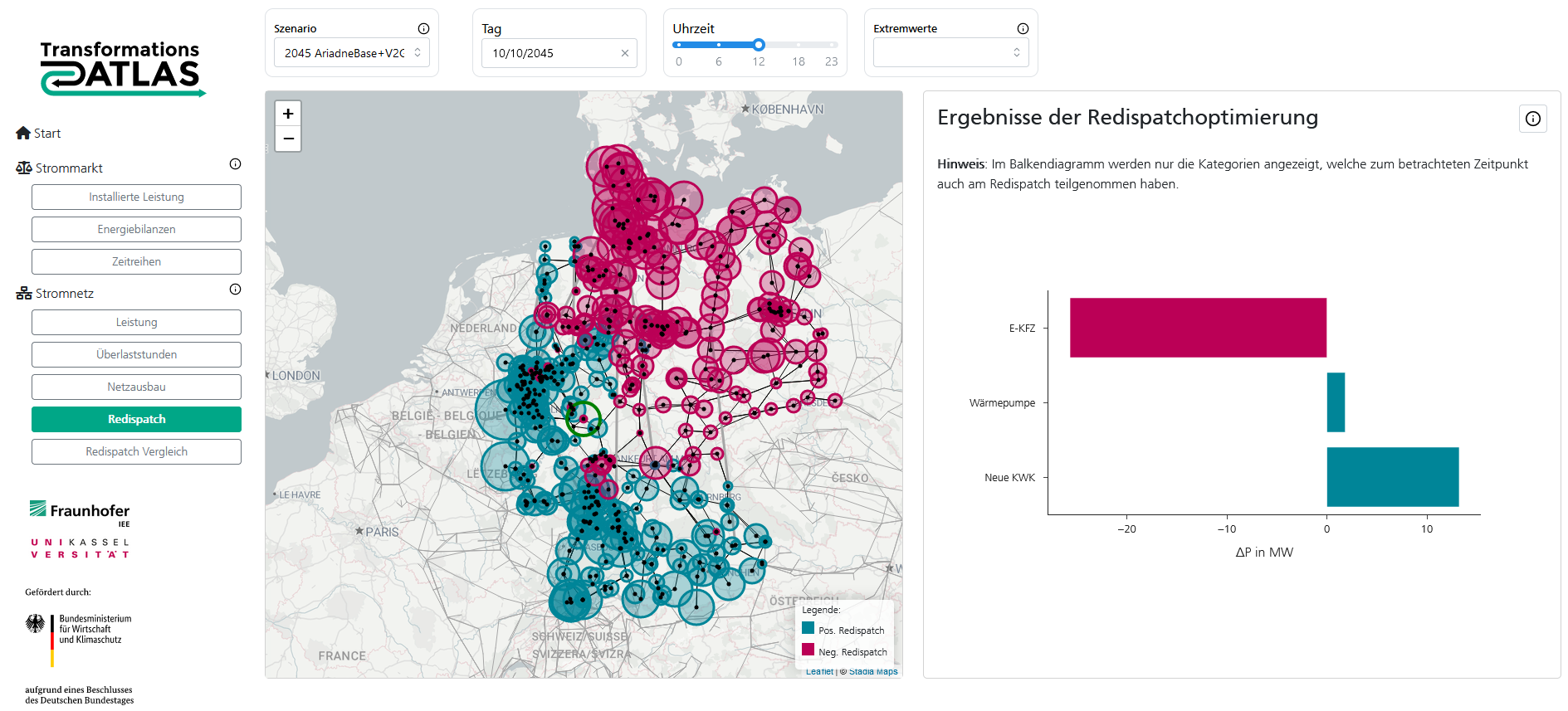Interactive transformation atlas demonstrates the interplay between the electricity market and electricity grid as a result of increasing electromobility
The demand for electricity will increase due to electromobility and heat pumps. This means that the number of wind energy and photovoltaic systems will also have to grow. What does this mean for the electricity grids, also in terms of peak loads and the weather dependency of generation plants? Fraunhofer IEE and the University of Kassel are now investigating this in the Federal Ministry for Economic Affairs and Climate Action-funded project "Decarbonization Transport - Energy System Feedback" (DeV-KopSys-2) with a focus on the mobility sector. The scientists are presenting their results in a spatially and temporally high-resolution, interactive transformation atlas. Individual queries are also possible free of charge via this link.


"The future of transportation is electric - especially with direct electric drives on the road, but also with electricity-based PtX fuels in aviation and shipping. Electricity, green hydrogen and its PtX downstream products are also replacing fossil fuels in other sectors," explains Maximilian Pfennig, Project Manager at the Fraunhofer Institute for Energy Economics and Energy System Technology IEE in Kassel. "We have investigated the challenges this poses for the grids and how they can be overcome. In doing so, we are creating a knowledge base for the holistic, coordinated planning of our future energy system."
In the current version of the transformation atlas, the scientists have initially limited themselves to the situation in Germany, taking into account the interfaces between the domestic energy system and the European electricity market. In the further course of the project, the Fraunhofer IEE and the University of Kassel will also examine the European and global transformation of energy systems.
The DeV-KopSys-2 project builds on the "Global PtX Atlas", which Fraunhofer IEE published in 2021 in the predecessor project DeV-KopSys. The atlas examined the respective potential for the sustainable production of green hydrogen and synthetic fuels in detail in those regions outside Europe that offer the best conditions for this.
Transparency throughout the transformation
Detailed scenario-based modeling was carried out for the analyses, with a temporally and spatially high-resolution representation of the respective generation, load and grid situations. Users of the transformation atlas have the opportunity to interactively understand their interaction and carry out their own evaluations.
The Fraunhofer IEE's transformation atlas offers various scenarios up until 2045, each with an entire weather year in hourly resolution, a representation of power growth and energy balances at federal state level and later also at district level, as well as electricity grid maps with the necessary grid expansion planning and management of remaining bottlenecks (redispatch). The atlas also shows the contribution that flexibility options can make in order to eliminate grid bottlenecks.
Furthermore, the atlas illustrates how new generators and consumers affect the electricity grid in spatial terms - such as high-performance electrolysers, large-scale storage facilities, offshore wind energy and electromobility. It also outlines the consequences of very high regional photovoltaic feed-in and European electricity trading for the grids.
"In a nutshell: with the Transformation Atlas, we demonstrate what happens on the market and in the grid when new producers and consumers have to be integrated," says Fraunhofer researcher Lukas Jansen. "In this way, we are creating transparency - and helping to make the complexity of the direct and indirect electrification of the transport and other sectors manageable."
Utilizing the potential of decentralized flexibility
The analyses show, for example, that in many places grid expansion alone is not enough to bridge the distances between the new generation and load centers. Decentralized flexibilities offer a remedy. First and foremost, electromobility: the grid-serving absorption and release of electricity into or from vehicle batteries ("Vehicle to Grid", or V2G for short) can help to eliminate grid bottlenecks and thus avoid the curtailment of wind turbines or photovoltaic systems. It is also possible to reduce the use of controllable thermal power plants. Such plants will continue to be indispensable in the future - they step in when renewable energies do not supply enough electricity due to the weather.
Free capacities of photovoltaic storage systems can also be used for grid-supporting services, as is evident from the atlas. Particularly in autumn and winter, they often offer a lot of unused redispatch potential, i.e. the adjustment of feed-in power in the event of grid bottlenecks at the request of the transmission system operators.
Integration at European and global scale
The team from Kassel will significantly expand their atlases over the next few years. While the currently published version focuses on the German energy system - including the effects of decoupling on the European electricity market - in the next step, scientists aim to focus even more on cause-and-effect relationships at the European level. For example, they are planning to visualize the future transnational hydrogen network.
At a later stage, the transformation paths of the global PtX exporting countries and their energy systems will also be modelled. Further research content will also be included, and users will be given even more opportunities to interactively retrieve information, for instance through time series-based elements at district level.
Further Information and Links
- Interaktiver Transformationsatlas (maps.iee.fraunhofer.de)
- Webseite DeV-KopSys
- Projektseite DeV-KopSys-2
Last modified: